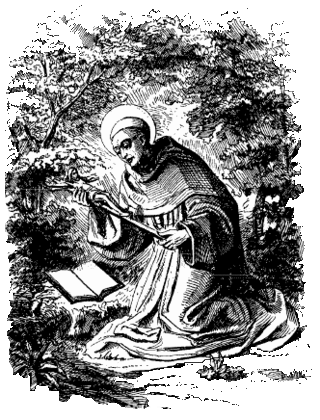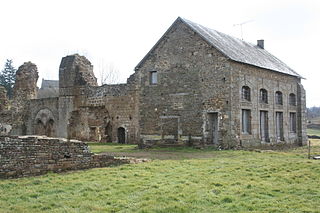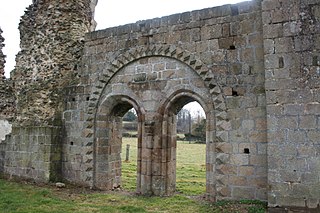Related Research Articles
Amadeus I, nicknamed of the Tail or la Coda, was an early count of the House of Savoy. He was probably the eldest son of Humbert I. His nickname derives from an anecdote, preserved only in a thirteenth-century manuscript, that when he met the Emperor Henry III at Verona in 1046, he refused to enter the emperor's chambers without his large train of knights, his "tail".

Father Damien or Saint Damien of Molokai, SS.CC. or Saint Damien De Veuster, born Jozef De Veuster, was a Roman Catholic priest from Belgium and member of the Congregation of the Sacred Hearts of Jesus and Mary, a missionary religious institute. He was recognized for his ministry, which he led from 1873 until his death in 1889, in the Kingdom of Hawaiʻi to people with leprosy, who lived in government-mandated medical quarantine in a settlement on the Kalaupapa Peninsula of Molokaʻi.

Basingwerk Abbey is a Grade I listed ruined abbey near Holywell, Flintshire, Wales. The abbey, which was founded in the 12th century, belonged to the Order of Cistercians. It maintained significant lands in the English county of Derbyshire. The abbey was abandoned and its assets sold following the Dissolution of the Monasteries in 1536.

Mont-Saint-Michel is a tidal island and mainland commune in Normandy, France.

Orderic Vitalis was an English chronicler and Benedictine monk who wrote one of the great contemporary chronicles of 11th- and 12th-century Normandy and Anglo-Norman England. Modern historians view him as a reliable source.

Robert, Count of Mortain, 2nd Earl of Cornwall was a Norman nobleman and the half-brother of King William the Conqueror. He was one of the very few proven companions of William the Conqueror at the Battle of Hastings and as recorded in the Domesday Book of 1086 was one of the greatest landholders in his half-brother's new Kingdom of England.

The Tironensian Order or the Order of Tiron was a medieval monastic order named after the location of the mother abbey in the woods of Thiron-Gardais in Perche, some 35 miles west of Chartres in France). They were popularly called "Grey Monks" because of their grey robes, which their spiritual cousins, the monks of Savigny, also wore.
Baldric of Dol was prior and then abbot of Bourgueil from 1077 to 1106, then made bishop of Dol-en-Bretagne in 1107 and archbishop in 1108 until his death. He fulfilled his monastic duties by travelling to attend Church councils and writing of poetry and history, his most influential piece being a historical account of the First Crusade.

Vitalis of Savigny was the canonized founder of Savigny Abbey and the Congregation of Savigny (1112).

The monastic Congregation of Savigny started in the abbey of Savigny, situated in northern France, on the confines of Normandy and Brittany, in the Diocese of Coutances. It originated in 1105 when Vitalis of Mortain established a hermitage in the forest at Savigny in France.
Haimo, also spelled Hamo, Heimo, Hamon, Haim, Haym, Heym, Aymo, Aimo, etc., is a masculine given name of Germanic origin. The Old French forms are Haimon, Aymon, Aimon, Aymes. It is a hypocoristic form of various Germanic names beginning with the radical haim-, meaning "home".

Normandy was a province in the North-West of France under the Ancien Régime which lasted until the later part of the 18th century. Initially populated by Celtic tribes in the West and Belgic tribes in the North East, it was conquered in AD 98 by the Romans and integrated into the province of Gallia Lugdunensis by Augustus. In the 4th century, Gratian divided the province into the civitates that constitute the historical borders. After the fall of Rome in the 5th century, the Franks became the dominant ethnic group in the area and built several monasteries. Towards the end of the 8th century, Viking raids devastated the region, prompting the establishment of the Duchy of Normandy in 911. After 150 years of expansion, the borders of Normandy reached relative stability. These old borders roughly correspond to the present borders of Lower Normandy, Upper Normandy and the Channel Islands. Mainland Normandy was integrated into the Kingdom of France in 1204. The region was badly damaged during the Hundred Years War and the Wars of Religion, the Normans having more converts to Protestantism than other peoples of France. In the 20th century, D-Day, the 1944 Allied invasion of Western Europe, started in Normandy. In 1956, mainland Normandy was separated into two regions, Lower Normandy and Upper Normandy, which were reunified in 2016.
Robert de Grantmesnil also known as Robert II, was a Norman nobleman; a member of a prominent Norman family. He first became a monk, then abbot at the Abbey of Saint-Evroul in Normandy and later Bishop of Troina in the Norman Kingdom of Sicily.

Savigny Abbey was a monastery near the village of Savigny-le-Vieux (Manche), in northern France. It was founded early in the 12th century. Initially it was the central house of the Congregation of Savigny, who were Benedictines; by 1150 it was Cistercian.

Vaux-de-Cernay Abbey was a Cistercian monastery in northern France (Ile-de-France), situated in Cernay-la-Ville, in the Diocese of Versailles, Yvelines.
Bernard of Thiron, also known as Bernard of Ponthieu and Bernard of Abbeville, was the founder of the Tiron Abbey and the Tironensian Order.

Grestain Abbey was an 11th-Century Benedictine monastery near the town of Fatouville-Grestain, which is located in the modern-day Eure département of Upper Normandy, France. The abbey was in the Catholic Diocese of Lisieux. Closely associated with the family of William, Duke of Normandy, the abbey was instrumental in the Normans taking control over the Church in England in the centuries following the Norman Conquest of England, establishing new churches and priories in England, and Abbots of Grestain ordained many English priests. Many churches mentioned in the Domesday Book of 1086 cite Grestain as the founding establishment.

The Mont-Saint-Michel Abbey is an abbey located within the city and island of Mont-Saint-Michel in Normandy, in the department of Manche.
Aymon de Briançon was a Burgundian nobleman and Carthusian monk who served as the archbishop of Tarentaise from around 1175 until his death. From 1186, he was a prince of the Holy Roman Empire. He took part in the Third Crusade in 1189.

The Abbey of Saint-Antoine was the mother abbey of the Hospital Brothers of Saint Anthony. It is located in Saint-Antoine-l'Abbaye, in the department of Isère, in France. It includes an abbey church and premises that once housed the monks' homes.